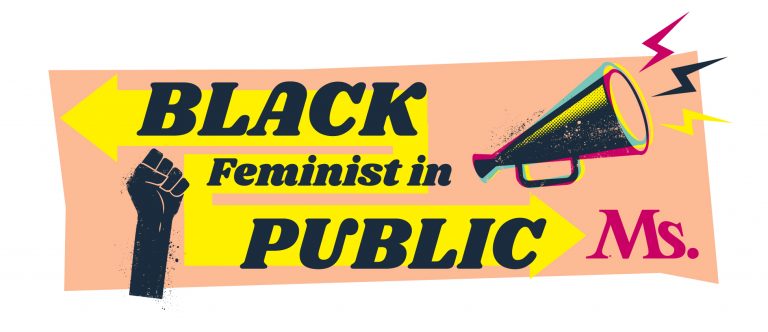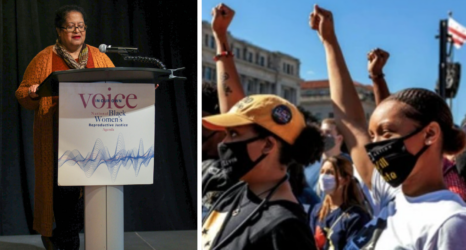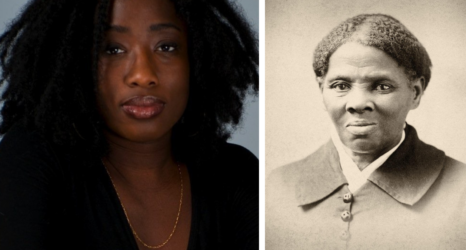
Black Feminist in Public is a series of conversations between creative Black women and Janell Hobson, a Ms. scholar whose work focuses on the intersections of history, popular culture and representations of women of African descent.
Erica Armstrong Dunbar is the Charles & Mary Beard Professor of History at Rutgers University and author of the critically acclaimed Never Caught: The Story of Ona Judge. Her new biography of Harriet Tubman, She Came to Slay: The Life and Times of Harriet Tubman, was released in time with the new film, Harriet, finally bringing her story to the big screen.
Dunbar, the first Black woman since Ann Petry to author a Harriet Tubman biography, talked to Ms. about the Black feminist approach that shaped the text and her thoughts on the movie out now.
What started you on this path to writing about Harriet Tubman?
My work centers on African-American women’s experiences, and more specifically, those experiences of enslaved people. My most recent book prior to She Came to Slay looked at and examined the life of another fugitive, Ona Judge, who ran away from slavery, from first president George Washington. For me, I’ve spent, you know, 20 years almost, sort of thinking about, talking about and writing about the experiences of enslaved women who attempted to find freedom in different ways.
I was in conversation with my editor, Dawn Davis, and she had been, of course, in conversation with Debra Martin Chase, executive producer of Harriet, and we knew that the film was coming out this fall, and she approached me about writing some kind of biography of Tubman, and it would be kind of left up to me on how I wanted to present it, but something that was popular, something that was accessible, something that allowed us, or at least a reading audience to make connections to Tubman as a nineteenth-century warrior to today. When she approached me about this, I said yes. I’ve taught Tubman for many, many years, and then it was really an opportunity to kind of further my work as a scholar of fugitives, of enslaved women, their lives as enslaved people, and then as people who live in freedom. That’s sort of how I came to the project.
This book is a companion book, not technically linked to the film, but I do think that when we have an opportunity such as a biopic of Tubman, to think about her deeply and across her very long and rich life, I’m hoping that people will want to read the book in tandem with going to the movies.
How does your book compare to some of the other biographies on Tubman?
One of the first things I did before sitting down to write was to go back and look at all of the Tubman biographies that have been published over the past 20, 30 years–and in reality we haven’t had a book on Tubman for some time.
There was a book that came out in 2008, and before that we had two books, one by Kate Clifford Larson and one by Catherine Clinton, that came out in the early 2000s, so really about 15 years have passed. Both Clinton and Larson do wonderful jobs of excavating Harriet’s life and bringing the details of her life forward. But, what I wanted to do, much in the way we see with the film Harriet, was I wanted us to see a different Harriet Tubman, to not simply see an elderly woman with her head covered, the kind of image that we have of Tubman that has proliferated through history textbooks across the nation, but to see her as a young woman, as a child first, as a young woman, as a married woman, later on as a mother, as a baker, as an entrepreneur, as a participant in the civil war, as a civil rights activist and a suffragette.
These were all of the things that I wanted to bring forward in a way that was accessible, that people would read and connect to.
You describe yourself as being the first Black woman to write a Tubman, at least since 1955. What difference do you think this makes? Are you using a Black feminist approach to her biography?
I think that Black women, Black scholars, have worked on Tubman for many, many years—but when we think about books or texts that are positioned for a large reading audience, I believe I am the first to do that.
I do think that’s important, when we think about who is positioned to tell the stories, to repeat or recite the history, and to offer analysis and interpretation of history, from this period—not simply about Harriet Tubman, but really about anyone. For me, it’s important to make certain that there is a diverse voice, a diverse number of people, or that there are different people telling similar stories, because we all bring different interpretations and different experiences to the writing of history.
For Tubman and any other history project, I believe it’s important to have a variety of folks weighing in on Tubman’s experiences. I do think it’s important to have historians from all walks of life to weigh in on the stories of America. Tubman is one of those stories. For me it’s really an honor to be able to interpret and present a more modern version of Tubman for a larger audience and to do it in a way that reminds us of the deep pain associated with slavery, but also the great triumph that came with emancipation, and the ways in which Black people, in particular Tubman, managed to find ways to live, love and survive a system that was created to debase and demoralize them at every turn.
You had mentioned the film Harriet. What are your thoughts on the film in general?
I’m so delighted that this film is appearing now, and that we have an opportunity to see Tubman through the lens of Black women. When we think about the writer, one of the writers, director, one of the executive producers, are all Black women, I do think that that matters as we weigh the importance of perspective and vision. The reality is, we have very few major feature films that center the experiences of slavery, of enslavement, specifically of enslaved women. There’s probably a handful. To have this kind of film appear now, in conjunction with the recent conversation about Tubman replacing, or appearing, on the $20 bill, I think all of this is sort of timely to have Black women tell this story, everything from how Tubman is presented as a young woman, to the score of the film, the aesthetics. This film takes the story of Harriet Tubman, the person Harriet that people think they know, and show us that we actually don’t know that much about Tubman, and to help us get into the interior of her life.
What would you say that most of us don’t know about Harriet Tubman that we might learn from the film, or even what we might learn from your book?
The film focuses on the years of Tubman’s young adult life, from the moment that she’s contemplating escape up through her participation in the civil war. That’s really sort of thinking about the years 1849 through 1863, so we’re covering less than a 20-year time period in the film. I think what the film does is show us who Araminta Ross was and how she became Harriet Tubman: that Araminta Ross was born to Harriet Green and Benjamin Ross, her mother and father, who were married, and although lived apart at different times, she was one of nine children. It kind of introduces Araminta as a woman who, although trapped in the violence of slavery, was able to create family relationships and love with her first husband, John Tubman.
All of these things, I think, give a multi-dimensional aspect to Tubman for the film. What my book does is it focuses—because I have the opportunity to not have a simple two-hour time period, which is what filmmakers have to work with; they have to make decisions about what they’re going to include and what they’re not going to include, and so I respect the decision that the filmmakers made for Harriet. I have the benefit though of doing more of a chronological examination of Tubman, so my book really begins with the trans-Atlantic crossing of her grandmother, a woman named Modesty.
Modesty arrives on the eastern shore of Maryland. We’re not exactly sure when, but sometime towards that latter part of the eighteenth century, and it allows me to use Modesty’s journey to talk about the trans-Atlantic slave trade and to connect Harriet directly to an African descendant. Then I’m able to weave in her experiences as a young child, what it meant, sort of thinking about girlhood and slavery. Really sort of thinking about her as a five- or six-year -old child who is taken away from her mother to basically serve another family on another farm as a child, as a baby who probably did not yet have her adult teeth. When we think about who she was as a child, how she matures, how she becomes the Araminta Ross who makes the decision to marry John Tubman, to eventually become Harriet Tubman and to flee, I have the ability to do that in the text.
My book allows us to travel really from the cradle to the grave.
Your book’s title, She Came to Slay, immediately made me think of possible connections between Harriet Tubman and Beyoncé. Are there connections between the two icons?
I was more interested in making connections with contemporary culture and music in order to bring readers to a subject matter that’s thought of as long ago and far away; there’s less interest in the stories of enslavement because that was then, and this is now.
What I wanted to do by using titles or call outs within the book was to help current readers, modern readers, make these strong connections between the past and the present—that yes, the civil war ended the enslavement of Africans in the United States, however, the vestiges of slavery still exist, and we see that in multiple ways, even across contemporary culture. What better way to get readers interested in the past than connecting them to titles and phrases that ring interesting to them and familiar?
The cover of the book has her holding a gun; in the textbooks we have of Tubman, rarely is she seen holding a gun. Why have we felt the need to remove Harriet from gun ownership? Of course she had a gun. She put herself in constant danger, and she knew that the people who would be coming after her would be armed to the teeth. Some of the people who traveled with her also had guns. That was a central part of her mission. So why not position her as she came to slay?
She came to slay slavery. She came to remove her friends and family from the most violent system in the United States. She came, and she did it, armed and ready. If we think about the importance of activism today, because clearly Harriet Tubman was an activist, you have to have that mentality that you are ready and willing to go fight and slay the beast in order for justice to prevail.





